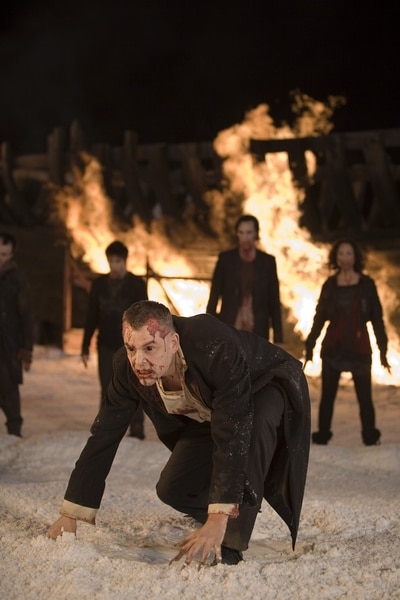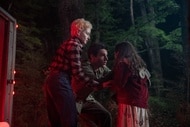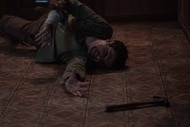30 Days of Night Director Talks "Burning Man" for Vampires, Sequel Ideas & Avoiding The Thing
30 Days of Night is now streaming on Peacock!

In 2007, as the vampire genre entered its sexiest era yet with the publication of Stephanie Meyer's bestselling Twilight books, director David Slade dared to bite against the grain with 30 Days of Night (now streaming on Peacock).
The fanged members of the undead in this movie had nothing in common with the sparkly, brooding bloodsuckers surrounding Bella Swan. "They were very much the antithesis of that," Slade, who would — ironically — go on to direct The Twilight Saga: Eclipse several years later, tells SYFY WIRE over Zoom. "There’s no [turning into] bats, there’s no capes, there’s none of that stuff. We wanted them to be like a pack of dogs, we wanted them to be feral."
What is 30 Days of Night about?
Based on the IDW comic of the same name by writer Steve Niles and artist Ben Templesmith, 30 Days of Night takes place in the remote Alaskan town of Barrow (now known as Utqiaġvik), where the sun literally doesn't shine between November and January.
Taking advantage of this "polar night" is a group of marauding vampires who discover they can feed on the town's residents for weeks on end without fear of burning up in daylight. "I just thought it was a great punk rock, high-concept vampire movie," Slade says. "In Ben’s artwork, there were these vampires I hadn’t seen before. Punk rock, monster-types. There was none of the romance, it was all very visceral."
Moreover, the idea that these nomadic, pre-True Knot parasites (led by Danny Huston's Marlow) had been doing this for centuries really appealed to Slade, who was fresh off the momentum of his feature debut, Hard Candy, at Sundance two years before.
"They would just go to places where they could feast and have a little festival, like a Burning Man [for vampires]," he adds. "They've chosen not to be cultural. They've chosen just to do this, which I think has great strength. I remember at one point, one of the executives at Sony went, ‘Is it a metaphor for capitalism?’ And I'm just like, ‘No. It's [about] the basest desires of the human condition.'"
As a result, the vampires became a subtextual allegory for addition. "We wanted this sense that that they were always hungry," Slade explains. "They needed to feast, they had to feast, and they enjoyed it."
The dead-eyed ghouls tear through their ample prey with ease, leaving only a small band of terrified survivors in their wake. The group's only hope at seeing the sun again lies in Barrow Sheriff Eben Oleson (a post-Faculty, pre-Trap Josh Hartnett) and his estranged wife, Stella (Melissa George), who immediately take charge. Beyond the IDW source material, Slade's main source of inspiration was George R.R. Martin's 1982 vampire novel, Fevre Dream. "I’m very open about the influences that were there because I’m a huge fan of it," he admits. "I’m a massive fan of George Martin. I got to meet him and tell him all this stuff and he was really cool."
Of course, the idea of a frozen outpost stalked by seemingly immortal monsters immediately brings to mind John Carpenter's The Thing, though Slade insists he didn't look at the 1982 classic for ideas. "The Thing is a great parallel for this, but I remember watching it going, ‘It's just its own thing. I love it and there's nothing much for me to take from this. Let's just keep going doing what we're doing,'' he remembers. "But … I would be very grateful if people suggested it was an influence in some way."
With Sam Raimi on board as producer and a completed script from Niles, Stuart Beattie, and Brian Nelson, production kicked off at a former military base in Auckland, New Zealand. The location not only made sense for tax reasons, but it was also near the headquarters of Peter Jackson's renowned effects studio, Wētā.
Given that New Zealand isn't exactly known for having a frigid climate, however, Slade and his team had to rely on cinematic sleight of hand. "We did every fake snow gag — from Epsom salts to foam to tiny bits of paper," he reveals. "[Production designer Paul D. Austerberry] is from Toronto and he knows snow. He just did an awesome job making everything feel as real as if we were there."
With so many night shoots on the schedule, the cast and crew ended up becoming like vampires themselves. "Things get kind of weird," Slade notes. "We were living the vampire life, which actually helped."
Will we ever get a proper sequel to 30 Days of Night?
30 Days of Night swooped into theaters on October 17, 2007 — just in time for the Halloween season — and raked in $75 million at the worldwide box office against a budget of $30 million. While it did turn a profit, the film was still considered a flop by the studio. "A film is [either] a hit or a bomb," Slade says of the binary outlook maintained by modern film companies. "There's nothing in between." With that said, the director considers the movie a cult classic "because it didn't disappear" from the cultural conversation. "It still has an audience. People still talk about it. People are still interested in that film and I think that's how you define a cult film."
There's also the fact that the IP lived on in a direct-to-video sequel, 30 Days of Night: Dark Days (2010), and a pair of television miniseries: Blood Trails and Dust to Dust. Slade was not involved with any of those follow-ups, though he does remember a brief period, "a long time ago," where Fede Alvarez (Don't Breathe, Alien: Romulus) tried and failed to get a TV adaptation off the ground.
For his part, Slade wanted to make a proper sequel centered around the Stranger (Ben Foster). Inspired by the figure of R.M. Renfield in the original Dracula story, the character helps the vampires prepare for their nocturnal banquet by cutting the town off from the rest of the world just before the sun sets. And even though the Stranger has his neck broken by Marlow in the Barrow police station, his body mysteriously disappears, which would have left some wiggle room for a resurrection.
"I know he's a dead, but somehow he's not dead. Let's follow him, because he's interesting, and let him reconstruct the entire pack of vampires again somewhere," Slade says. "Maybe it's in Louisiana or whatever, with the aim of then going back to Alaska to feast ... I don't know whether that's still viable anymore, but it's just such a rich world."
He concludes: "We’re all doing various different things, but I'd like to do a sequel, or even just another story in that world. It has to be right, it has to be interesting, it has to not be derivative. The thing about vampires is all the parts have been stripped from all the good stories. It's difficult to find a new vampire story. I love vampires. I definitely will make another vampire movie. I don't know what it is yet, but I definitely will at some point, because I love [them]. They’re so rich for the human condition."
30 Days of Night is now streaming on Peacock.


























